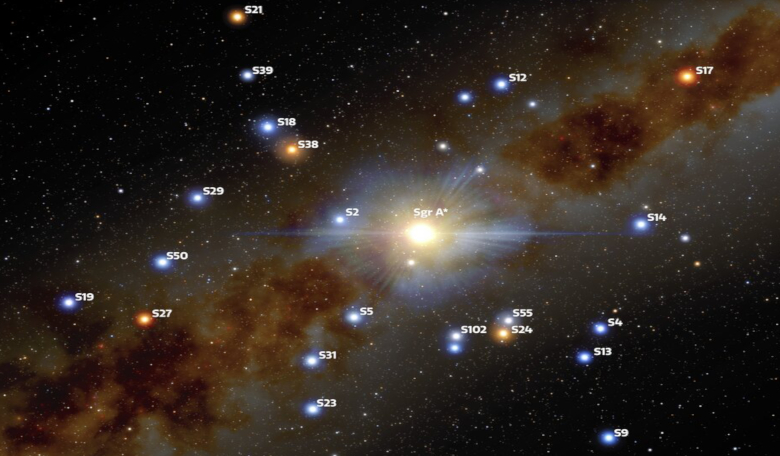By making the most precise measurements yet of the motions of stars around Sagittarius A*, the supermassive black hole at the centre of the Milky Way, astronomers have calculated that a staggering 99.9 percent of the mass contained at the very center of the galaxy is due to the black hole, and only 0.1 percent could include stars, smaller black holes, interstellar dust and gas, or dark matter.
Located roughly 27,000 light-years from the Sun, the centre of our galaxy is dominated by a supermassive black hole 4.3 million times as massive as the Sun.
Although scientists had long suspected that this compact radio source, known as Sagittarius A* or Sgr A* for short, was indeed a black hole, it was only after years of painstaking observations of the motion of stars around Sgr A* that led to confirmation that the black hole existed. This pioneering work was led by groups headed by Reinhard Genzel and Andrea Ghez, and their efforts won the duo half a Nobel Prize in Physics in 2020.
Since then, Genzel and colleagues have been working on confirming more details about Sgr A*, specifically, is general relativity indeed the correct theory of gravity in this extreme laboratory, and is there anything else hidden at the centre of the Milky Way.
“The most straightforward way to answer that question is to closely follow the orbits of stars passing close to Sgr A*,” says Stefan Gillessen, one of the astronomers who set out to do just that.
According to a prediction made by Einstein’s general theory of relativity stars orbiting around a supermassive compact object will trace out an elegant rosette shape as they move around it. This is known as a Schwarzschild precession.
Measuring the minute variations in the orbits of distant stars around our galaxy's supermassive black hole is incredibly challenging, but by tracking the position and velocity of four stars, S2, S29, S38, and S55, with the Gemini Near Infrared Spectrograph (GNIRS) at Gemini North and the SINFONI instrument on the European Southern Observatory’s Very Large Telescope, the team found that the stars were following this predicted precessional motion.
Whats more, from the observations the team were able to infer the distribution of mass within Sgr A*.
They discovered that any extended mass within the orbit of the S2 star contributes at most the equivalent of 0.1 percent of the mass of the supermassive black hole. This meant that the mass in the centre of the Milky Way is almost entirely due to the Sgr A* black hole, leaving very little room for anything else.
“We are very grateful to Gemini Observatory, whose GNIRS instrument gave us the critical information we needed,” said Genzel, who is also the director of the Max Planck Institute for Extraterrestrial Physics. “This research shows world-wide collaboration at its best.”
The team have plans to measure even fainter stars with even greater precision, but in order to do that, they will have to wait until telescopes such as the Giant Magellan Telescope and the Thirty Meter Telescope (both part of the US-ELT Programme) become operational.
“We will improve our sensitivity even further in future, allowing us to track even fainter objects,” concluded Gillessen. “We hope to detect more than we see now, giving us a unique and unambiguous way to measure the rotation of the black hole.”
The team's research; “The mass distribution in the Galactic Centre from interferometric astrometry of multiple stellar orbits” will be published in Astronomy & Astrophysics.











